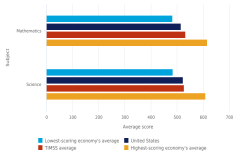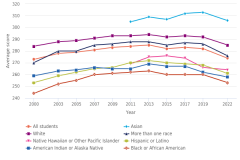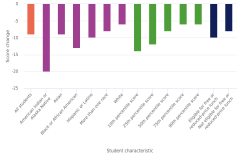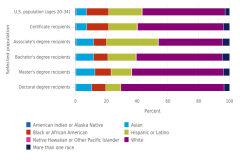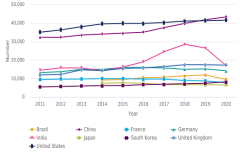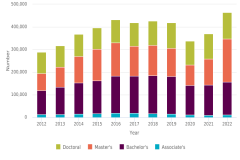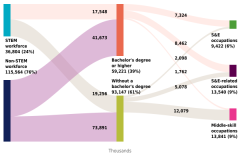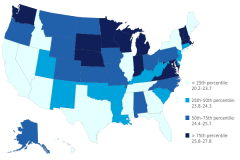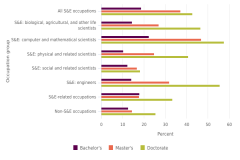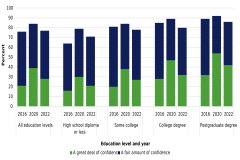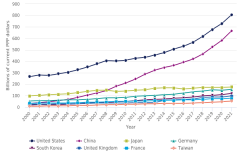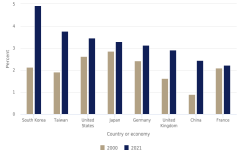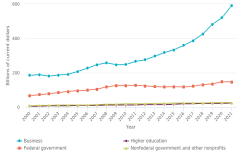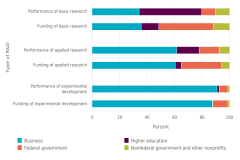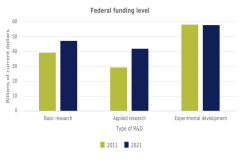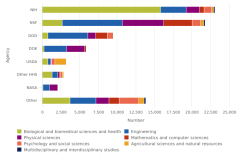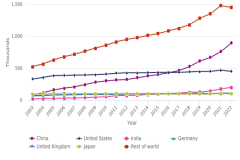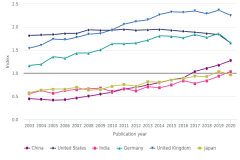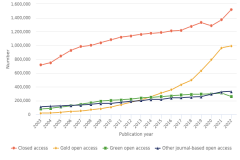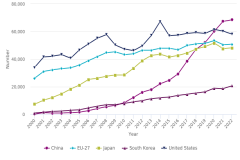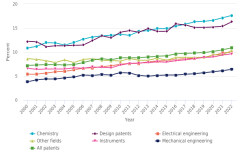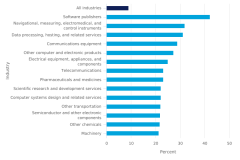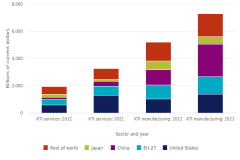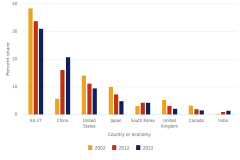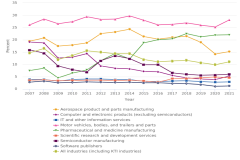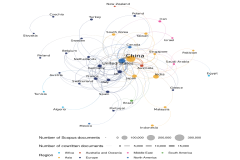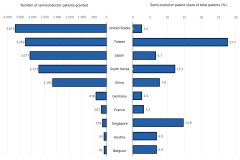| Figure 1 |
Average TIMSS mathematics and science scores of students in grade 8 among participating advanced economies: 2019 |
International Association for the Evaluation of Educational Achievement |
Trends in International Mathematics and Science Study |
| Figure 2 |
Average scores of U.S. students in grade 8 on the main NAEP mathematics assessment, by race or ethnicity: 2000–22 |
National Center for Education Statistics |
National Assessment of Educational Progress |
| Figure 3 |
Change in average student scores for 13-year-old students on the NAEP long-term trend mathematics assessment, by student characteristic: 2020–23 |
National Center for Education Statistics |
National Assessment of Educational Progress |
| Figure 4 |
Race or ethnicity in the U.S. population and among S&E certificate and degree recipients: 2021 |
National Center for Education Statistics |
Integrated Postsecondary Education Data System (IPEDS), Completions Survey |
| Figure 4 |
Race or ethnicity in the U.S. population and among S&E certificate and degree recipients: 2021 |
U.S. Census Bureau |
Population Estimates Program |
| Figure 5 |
S&E doctoral degrees awarded, by selected country: 2011–20 |
Government of India, Ministry of Education, Department of Higher Education |
All India Survey on Higher Education |
| Figure 5 |
S&E doctoral degrees awarded, by selected country: 2011–20 |
Ministry of Education, People's Republic of China |
Higher Education Data |
| Figure 5 |
S&E doctoral degrees awarded, by selected country: 2011–20 |
National Bureau of Statistics of China |
China Statistical Yearbook |
| Figure 5 |
S&E doctoral degrees awarded, by selected country: 2011–20 |
Organisation for Economic Co-operation and Development |
Education at a Glance |
| Figure 6 |
International S&E students on temporary visas enrolled in U.S. higher education institutions, by level of enrollment: 2012–22 |
U.S. Department of Homeland Security, U.S. Immigration and Customs Enforcement |
Student and Exchange Visitor Information System (SEVIS) |
| Figure 7 |
U.S. workforce, by STEM occupation group and education level: 2021 |
U.S. Census Bureau |
American Community Survey |
| Figure 8 |
Employment in the STEM workforce, by state: 2021 |
U.S. Census Bureau |
American Community Survey |
| Figure 9 |
Foreign-born share of workers with a bachelor's degree or higher, by highest degree level and occupation group: 2021 |
National Center for Science and Engineering Statistics |
National Survey of College Graduates |
| Figure 10 |
Respondents expressing confidence in scientists to act in the best interests of the public, by education level: 2016, 2020, and 2022 |
Pew Research Center |
American Trends Panel |
| Figure 11 |
Gross domestic expenditures on R&D, by selected country or economy: 2000–21 |
Organisation for Economic Co-operation and Development |
Main Science and Technology Indicators |
| Figure 12 |
R&D intensity, by selected country or economy: 2000 and 2021 |
Organisation for Economic Co-operation and Development |
Main Science and Technology Indicators |
| Figure 13 |
U.S. R&D expenditures, by performing sector: 2000–21 |
National Center for Science and Engineering Statistics |
National Patterns of R&D Resources |
| Figure 14 |
U.S. R&D expenditures, by source of funds: 2000–21 |
National Center for Science and Engineering Statistics |
National Patterns of R&D Resources |
| Figure 15 |
U.S. R&D performance and funding, by type of R&D and sector: 2021 |
National Center for Science and Engineering Statistics |
National Patterns of R&D Resources |
| Figure 16 |
U.S. R&D performance funded by the federal government of each type of R&D: 2011 and 2021 |
National Center for Science and Engineering Statistics |
National Patterns of R&D Resources |
| Figure 17 |
Full-time graduate students in S&E primarily supported by the federal government, by degree field and agency: 2021 |
National Center for Science and Engineering Statistics |
Survey of Graduate Students and Postdoctorates in Science and Engineering |
| Figure 18 |
S&E articles, by selected region, country, or economy: 2003–22 |
Elsevier |
Scopus |
| Figure 19 |
Highly cited article index, by selected country: 2003–20 |
Elsevier |
Scopus |
| Figure 20 |
S&E articles, by publication access type: 2003–22 |
Elsevier |
Scopus |
| Figure 21 |
Patent Cooperation Treaty applications, by selected region, country, or economy: 2000–22 |
European Patent Office |
European Patent Bibliographic Data (EBD) |
| Figure 22 |
USPTO utility patents granted to inventors per 1,000 residents, by U.S. county: 2022 |
U.S. Census Bureau |
Population Estimates Program |
| Figure 22 |
USPTO utility patents granted to inventors per 1,000 residents, by U.S. county: 2022 |
United States Patent and Trademark Office |
PatentsView |
| Figure 23 |
Inventors with female names on granted USPTO patents, by technology area and issue year: 2000–22 |
United States Patent and Trademark Office |
Bulk Data Storage System |
| Figure 24 |
U.S. companies reporting product innovation, by selected industry: 2018–20 |
National Center for Science and Engineering Statistics |
Annual Business Survey |
| Figure 25 |
Value-added output of KTI industries, by selected region, county, or economy and by sector: 2012 and 2021 |
S&P Global |
Comparative Industry Service |
| Figure 26 |
Share of global KTI manufacturing exports, by selected country or economy: 2002, 2012, and 2022 |
S&P Global |
Comparative Industry Service |
| Figure 27 |
Imported content share of U.S. gross exports, by exporting industry: 2007–21 |
U.S. Bureau of Economic Analysis |
Global Value Chains |
| Figure A |
AI collaboration network, by country: 2003–22 |
Elsevier |
Scopus |
| Figure B |
USPTO utility patents granted in semiconductors, by country or economy: 2022 |
United States Patent and Trademark Office |
PatentsView |
| Table 1 |
Distribution of select racial and ethnic groups in the workforce, by occupational group: 2021 |
U.S. Census Bureau |
American Community Survey |
 An official website of the United States government
An official website of the United States government

